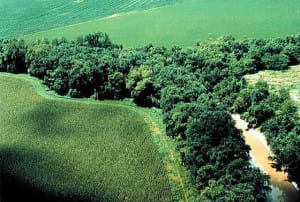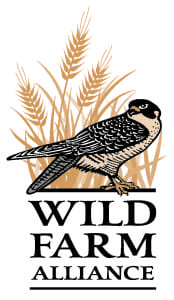Wild Farm Alliance
by Jo Ann Baumgartner
 |
| NOP guidance did not clearly stop degradation of lands with Conservation Reserve Program improvements when converted to organic crop production, although there is an example of best practices regarding this issue. Image source: Penn State |
On January 15, 2016 the National Organic Program (NOP) released the final version of their Natural Resources and Biodiversity Conservation Guidance. It comes after Wild Farm Alliance and partners wrote the initial text and subsequently led comments from the organic community on the NOP’s draft.
“We applaud NOP for clearly stating that certified operations are required to implement measures that support natural resources and biodiversity conservation, not just soil and water quality, which was the problematic misconception from the start,” said Wild Farm Alliance Executive Director Jo Ann Baumgartner. “Soil and water regulations have been addressed consistently by most operations and certifiers in the past, and now with this final guidance, there will be a uniform method for implementation of the natural resources and biodiversity conservation regulations by all.”
The final guidance retains much of the initial language we and our partners supplied, including a detailed set of examples for how an organic operation can maintain or improve soil, water, wetlands, woodlands and wildlife. It also gives clear direction on what the operation’s Organic System Plan (OSP) must contain, how certifiers must ensure that the OSP comprehensively supports natural resources and biodiversity conservation, and that inspectors must be able to evaluate areas where conservation already occurs, projects are planned, and improvement is needed. This is raising the bar to a higher level.
The guidance incorporates many of the important changes suggested during public comment period, including the improved language clarifying that non certified land can help an organic operator meet the requirements if that land directly benefits the certified land. In a round about way, the guidance now provides important definitions of biodiversity, high conservation value areas, riparian areas, and invasive plants and animals by adding them in the footnotes of the Examples section, since adding them in the Policies and Procedures section would have taken a rule change. Important links to threatened species and “at risk ecosystems” were likewise referenced in the Examples section.
The guidance now better highlights how domestic organic operations can participate in USDA Natural Resources Conservation Service (NRCS) programs, including one that helps transitioning farmers (Conservation Activity Plan 138), mentions others (Environmental Quality Incentive Program and Conservation Stewardship Program), and better aligns with NRCS by using their terms of “plans, practices and enhancements” to describe “activities.” It points out that conservation plans developed with NRCS or other conservation organizations can be referred to, but not take the place of, the Organic System Plan. These are all important and helpful modifications.
Unfortunately, but not unexpectedly, the guidance does not reduce the incentive to convert natural ecosystems into organic crop production by instituting a 5 year waiting period. (NOP requires that, in order to transition to organic certification, lands must be free from pesticides for three years. Despite often being highly erodible, land that has not been plowed or previously planted is an easy target for those looking to quickly overcome NOP’s three-year waiting period.) It would have been better to include this issue in the Guidance, and wait to see if it would be ignored by certifiers as the NOP hypothesized. If not ignored, implementation would be immediate, whereas now the next step of putting it in the rule will take years while natural ecosystems suffer. (WFA and partners are currently collaborating with conservationists, farmers and NOSB members to work a rule change that addresses this egregious issue.) Likewise the guidance did not clearly stop degradation of lands with Conservation Reserve Program improvements when converted to organic crop production, although there is an example of best practices regarding this issue.
Regrettably, the guidance removed the examples for handling operations, even though standard 205.200 refers to “operations.” The NOP seems unsure itself, stating that “Handling operations and their certifiers should determine whether handling operations directly affect biodiversity and take action as appropriate (and as required).” As a result, it will take a vigilant NOP accreditation staff to ensure uniform implementation by certifiers.
Disappointingly, the guidance did not include new suggested additions in the examples section regarding climate mitigations and adaptations. According to our newly added definition on “biodiversity,” part of it encompasses “the full range of natural processes including … carbon fixing.” Biodiversity conservation holds many solutions for reducing climate change impacts to the organic operation and to ecosystems in general.
Wild Farm Alliance and partners were successful in helping to make this Guidance a reality because of the support of the National Organic Standards Board over many years. We look forward to continuing to engage with the NOSB process to ensure the National Organic Program addresses conservation as well as possible. We will continue to track the guidance and implementation, sharing information through our e-newsletter and website.
This final guidance is available from the NOP through “The Program Handbook: Guidance and Instructions for Accredited Certifying Agents (ACAs) and Certified Operations” which is available online at http://www.ams.usda.gov/rules-regulations/organic/handbook.
 The Wild Farm Alliance was established by a national group of wildlands proponents and ecological farming advocates who share a concern for the land and its wild and human inhabitants.
The Wild Farm Alliance was established by a national group of wildlands proponents and ecological farming advocates who share a concern for the land and its wild and human inhabitants.
Our mission is to promote a healthy, viable agriculture that helps protect and restore wild Nature.
To make our food systems sustainable in the 21st century, we envision a world in which community-based, ecologically managed farms and ranches are seamlessly integrated into landscapes that accommodate the full range of native species and ecological processes.

Jo Ann Baumgartner is the Executive Director of the Wild Farm Alliance (WFA). She is the author of many publications on the intersection between biodiversity conservation and agriculture, the conservation benefits and mandates within the National Organic Program regulations, and the co-management of food safety and conservation. Before joining WFA in 2001, she addressed crop, livestock and fiber issues, was senior research editor for a book of California’s rare wildlife species, worked on a research project using wastewater on freshly eaten crops, and was an organic farmer for over a decade. For her Master’s research in Environmental Studies Department at San Jose State University, she studied bird predation of insects in apple orchards. Her undergraduate degree is in Soil and Water Science from UC Davis.

